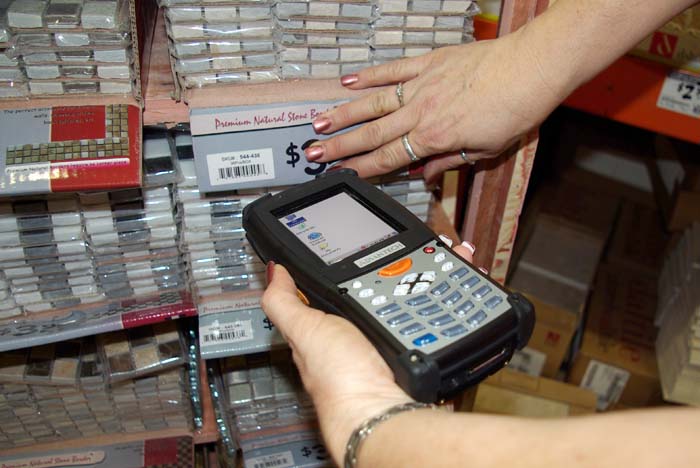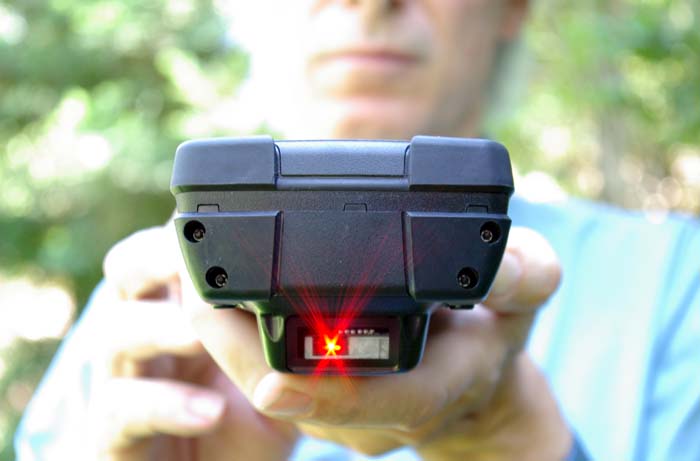|
Advantech MARS-1031
Rugged handheld terminal with 1D/2D scanner
(by Conrad H. Blickenstorfer -- view PDF version)
The MARS-1031 is a rugged handheld terminal made by Advantech, a Taiwanese embedded and industrial computing conglomerate. Founded in 1983, Advantech provides web-based technology, computing platforms and customization services in three business groups (embedded & industrial computing, eServices & applied computing, and industrial automation). Advantech has almost 3,500 employees, and operates a sales, marketing and support network in 18 countries. The company sells directly or works with third parties to provide complete computing solutions for various industries. These include medical computing, vehicle mounts, panels, industrial Tablet PCs such as the MARS-3100S and 3100R, and the rugged MARS-1031 handheld shown below.

A traditional handheld for tough jobs
The MARS-1031 is a tried-and-true rugged handheld computer design running the equally experienced Microsoft Windows CE 5.0 platform on a Marvell PXA27x processor. This is a tool for tough jobs in numerous field applications where it's all about reliability, functionality and a battery that lasts through a shift. The terminal is about 7.5 inches long, 3.5 inches wide, and about an inch and a half thick without a scanning module mounted at its bottom, and about three quarters of an inch thicker with one. Our tester weighed 21.5 ounces (1.35 pounds) with scanning module and battery installed.
The touch screen display is a standard 3.5-inch transflective LCD with 240 x 320 pixel QVGA resolution. This is the reliable screen technology that's been used for years in PDAs and Pocket PCs. The display is nice and bright indoors and remains very viewable outdoors. Viewing angle is limited both horizontally and vertically, as is usually the case on this type of display. Fortunately, that is not nearly as big a deal as with notebooks.
The PXA27x-powered MARS-1031 we reviewed represents a technology update to the predecessor MARS-1030 that ran Windows CE .NET 4.2 on a 400MHz Intel/Marvell PXA255 processor. Our MARS-1031 machine came with a 520MHz Marvell PXA270 processor, 128 or 256MB of RAM and 128MB of Flash memory. An 11.1 watt-hour Li-Ion battery pack provides full-shift (8 hours) operation under normal use. A 14.8 watt-hour extended battery is available as an option.
Neither hardware nor software of the 1031 is new or untested; this is technology that has been used in the field in numerous applications for years. So why continue with this approach as opposed to designing a sleek new and much smaller device with smartphone functionality?
Because these tool-for-the-job terminals are still needed. They are deployed around the world by the hundreds of thousands. In fact, for many companies the primary problem is that not that many vendors are offering these basic Windows CE workhorse handhelds anymore and they cannot find replacements when their handhelds break. So continuing to offer this type of rugged handheld makes a lot of sense, and especially so if it combines updated technology with the standard form factor that works so well.
Embedded technology
Why Windows CE .NET or Windows CE 5.0 instead of one of the most recent variants of Windows CE or Windows Mobile with all its bells and whistles and prettier user interface? Because Windows CE remains a very compact, very efficient and scalable operating system that was designed for a broad range of embedded systems and products and has plenty of programming support.
Further, CE's multi-threaded, multi-tasking, fully preemptive OS environment was targeted from the start specifically toward hardware with limited resources. Windows CE supports a rich subset of Microsoft Win32 APIs and several additional programming interfaces. As a longtime supporter of Windows CE for industrial applications, Advantech has considerable experience with the platform. With the Advantech 1030/1031 there is no need to create onboard drivers or using the Platform Builder to create a CE image; Advantech supplies that, and also a series of enhancement to make the creation of customized software even simpler.
However, keep in mind that CE was conceived as an embedded rather than a general purpose OS. While CE .NET and CE can include multimedia, PIM applications and communications tools, that is not the primary purpose here. Our tester came with essentially just three of the common applications--Microsoft WordPad, email and Pocket Internet Explorer. However, there were 22 control panels and utilities to configure and fine-tune the device, and a typical customer device will probably run some custom-designed application software.
Different hardware configurations
On the hardware side, the Advantech MARS-1031 can be ordered in two different keyboard configurations version, one with 24 keys (1031N) and one with a larger 44 alphanumeric key keypad (1031F) that is a couple of inches longer (9.7 vs. 7.6 inches) and a bit heavier. A pistol grip is available for ergonomic operation.
The 1031 is operated either via stylus, touch, or a four-way navigation diamond or the keypad. There are also three large orange scanner buttons, one each on either side and one right below the display. The keys are clear acrylic with the labels at the bottom of the key in white on gray (keypad) or gray on white (navigation and functions). Since they are at the bottom of the keys, the labels can be a bit difficult to read when viewed from an angle. The keys provide excellent tactile feedback and a mechanical click when pressing them.
Our review unit had the smaller keypad meant to be used for applications that primarily require numeric data entry. The keys are arranged in a standard phone keypad with a column of function keys to its left: ESC, BS (backspace), Alpha and Fn (function). The Alpha key toggles between numeric keypad and alpha. In alpha mode, things work a bit like on a cellphone. The "1" key can also issue an "A" (press once), "B" (press twice), or "C" (press three times). In alpha mode, the Backspace key toggles between lower case and caps. Obviously, the emphasis is on numeric data, and not text, entry, but just like on a cellphone, you can type the occasional text.
Above the keypad is a navigation diamond that doubles for page-up/page-down as well as volume and backlight adjustment. To the left and right of the diamond are two programmable function keys each.

Connectivity
For connectivity, the MARS-1031 supports USB 1.1 client with an included cable, and USB 1.1 host and RS-232 serial via an optionally available cable. The device has a use-accessible CF Card Type II slot and a SD Card slot (storage only; not SDIO). An optional PC Card slot can take the place of the CF card slot.
The 1031 can optionally be equipped with 802.11b/g WiFi, Bluetooth version 1.2, and also Tri-Band GSM (900/1800/1900 MHz) and GPRS.
Connection to a PC for synchronizing or communication with a backend server or peripheral can be via USB, WiFi or Bluetooth. Relationships can be established via standard Microsoft ActiveSync.
Scanning
For scanning applications, the Advantech MARS-1031 can be ordered with an optional 1D laser or 1D/2D imager and is thus capable of reading the following codes and symbologies:
- UPC-E (universal product code with zero-compression)
- UPC-A (universal product code with check digit)
- EAN-13 / ISBN (UPC-A prefixed with a 0)
- EAN-8 / JAN-8 (superset of UPC)
- UPC-EAN add-ON 2/5
- Interleaved 2 of 5 (very common continuous numeric code)
- Industrial 2 of 5 / IATA (older fixed width space code)
- Plessey / MSI (older code often used for retail shelves)
- Code 11 (often used for labeling telecomms equipment)
- Codabar / NW7 (library systems and similar)
- Matrix 2 of 5
- Code 32
- Code 39
- Code 93 (barcode primarily used by Canada Post)
- Code 128 / UCC EAN128 (high density code with three coding schemes; can use special characters)
- China Post
- Code 4, GTIN
- Korea Code 3 of 5
- RSS (Reduced Space Symbology)
- PDF417 (a stacked code symbology with error correction and over 1KB of data possible)
- DataMatrix (squares or rectangles made up of square dots)
- Aztec (A square code where data squares emanate out looking like a pyramid)
- Code 49 (stacked code with two to eight rows)
- Postnet, and
- QR
Ruggedness
A very rugged housing with protruding rubber bumpers on all corners lets the MARS-1031 survive multiple 5-foot drops and pass a variety of MIL-STD-810F tests for vibration, shock, humidity, and water/dust resistance. The operating temperature range is 14 to 122 degrees Fahrenheit, making the terminal suitable for freezer operation. While the prdecessor 1030 was IP54 certified where the "5" meant there is limited ingress for dust and the "4" signified protection against water spray from all directions, the 1031 is sealed to IP65 specification. That means it is totally sealed against dust and can handle water jets from all directions.
The entire device feels extremely solid and downright invulnerable. The sealed scanner module is secured with six Allen screws. Deeply recessed Allen screws are also used to hold the front and back halves of the unit together, and to secure the rubber bumpers. The battery sits under a thick plastic door that is held in place by two levers that you need to rotate by 90 degrees before the door can be removed. There is no way that the door accidentally comes off during a drop. The materials used are not scratch-prone either.
Summary
Overall, the Advantech MARS-1031 is a handy, fairly lightweight, and very rugged handheld based on field-proven hardware and software components that have been updated from the MARS-1030 predecessor model. The platform can be used in a very wide range of commercial and industrial applications that require ruggedness and flexibility.
The unit's powerful battery can last a full 8-hour shift. If that is not enough, a high capacity battery is available. A four-slot battery charger is offered so that charged power packs are available on demand.
The MARS-1031 is a highly configurable device that, depending on installed options, can handle data and voice communications and 1D/2D scanning in addition to conventional data capture applications. The availability of two different keyboards (16 and 44 keys) also helps in customizing the unit for a given task.

In summary, the Advantech MARS-1031 is a workhorse terminal built on field-proven technology that can flexibly and reliably handle a large variety of retail, warehousing, logistic and ordering service applications.
-- Conrad H. Blickenstorfer
Advantech MARS-1031N Specs:
| Type |
Rugged handheld terminal
|
| Processor |
520 MHz Marvell PXA270 |
| OS |
Windows CE 5.0
|
| RAM/ROM |
128-256MB/128MB FLASH |
| Display |
3.5" Transflective TFT with 240 x 320 pixel resolution and 262k colors |
| Digitizer |
Touch screen |
| Keyboard/keys |
24 or 44 alphanumeric key keypad with LED backlight |
| Navigation |
directional control
|
| Expansion slots |
1 CF Type II (or optional PC Card), 1 SD Card
|
| Housing |
plastic/metal
|
| Size |
3.6 x 7.6/9.7 x 1.7-2.2
|
| Weight |
1.2/1.45 lbs.
|
| Operating temperature |
14 to 122 degrees Fahrenheit |
| Ingress protection |
IP65 |
| Drop/shock/other |
5 foot drop |
| Power |
3,000mAH/3.7V Li-Ion ("8 hrs. at normal mode"); high capacity battery (4,000mAH/3.7V is available) |
| Interface |
Supports USB 1.1 client and host, RS232 (cable), optional 1D/2D scanner |
| Wireless options |
Optional: 802.11b/g, Bluetooth V1.2, GSM/GPRS
|
| Price |
depends on configuration |
| Contact |
Advantech www.advantech.com.tw |
(copyright 2008 RuggedPCReview.com)
Advantech Corporation
38 Tesla, Suite 100
Irvine, CA 92618
Toll Free: 1-800-866-6008
Ph: 949-789-7178
Fax: 949-789-7179
ECGInfo@advantech.com
www.advantech.com
Advantech Co. Ltd.
No.1, Alley 20, Lane 26, Rueiguang Road
Neihu District, Taipei Taiwan 114, R.O.C.
Tel: 886-2-2792-7818
Fax: 886-2-2794-7301
www.advantech.com
|



